Rachel Dodge's Blog, page 2
February 20, 2024
Brave Women Like You and Me
Who is the bravest woman you know?
Hint: It’s not me.
When I was asked to write an article about bravery, I got stuck for 6 weeks.
Until God showed me what true bravery means… and I began to notice all the brave women around me. Women who are doing incredibly courageous things each day, with little applause or acclaim, in their own way and in their own sphere.

Just like you.
Just like me.
And an idea began to form. And the words began to fly.
And when I was finished, I wanted to share it with every women I know.
I wanted the message to seep into their bones and into their hearts.

That every woman I know would see that God is making her brave in the everyday faithful things that she does.
Because we’re all in this together…
 Credit: Knights Templar web site, Joan of Arc
Credit: Knights Templar web site, Joan of Arc“Your brave will often look different than mine. Sometimes your easy will be my hard and vice versa. But we all need Jesus to help us take brave steps of faith in the areas where we lack courage.”

Thank you to @becky.beresford who asked me to write this and for hosting me on her Brave Women Series. You can read the article for yourself.
In it, I list over 40 kinds of bravery I see in the women around me.
I hope you’ll see yourself in it.
I hope you’ll share it with the women you love and admire.
I hope you’ll take it to heart.
If I could call you and read it to you over the phone, I would. You can read it here:
Read Brave Women Article HereWhat is your definition of a brave woman? Who is the bravest woman you know? Let’s honor the ladies in our lives!
You’re SO much braver than you think, Kindred Spirit!
Rachel xx

The post Brave Women Like You and Me first appeared on Rachel Dodge.
February 15, 2024
February in Jane Austen’s Novels
Last month I started a new series over at Jane Austen’s World, wherein I began exploring important events and details that happened in Jane Austen’s novels, letters, and lifetime during each month of the year. Starting with January in Jane Austen’s World, my aim is to share my monthly finds every month this year, through December. My goal is simple: Glean as much as I can from Austen’s life, letters, and novels about what life was like for Jane Austen during her time and era.
We now turn our attention to February in Jane Austen’s novels. As I examined passages in her novels and letters that mention February, some of the information I found was an extension of what we learned last month: Mainly, that most of the British aristocracy went to the London (and some to Bath) during the winter months for “the season.” They enjoyed balls, parties, and other social gatherings in the bigger cities during the colder months and then moved back to their country homes by summer when the heat and stench of the cities became unendurable. You can read about it here.
 Snowdrops at Chawton House in February, Photo: @ChawtonHouse.February in Hampshire
Snowdrops at Chawton House in February, Photo: @ChawtonHouse.February in HampshireThe snowdrops are in full bloom at Jane Austen’s House Museum and Chawton House this time of year. Chawton House even hosts “Snowdrop Sunday” tours, when guests can come visit the grounds and enjoy the stunning display of snowdrops and other bulbs that are starting to pop out.
I mention the snowdrops because they are everywhere on the grounds of Chawton House in the winter time, and it’s lovely to think that perhaps Jane Austen saw them for herself. These type of bulbs can spread and spread for years.
 Chawton House in February, Photo: @ChawtonHouse.
Chawton House in February, Photo: @ChawtonHouse.February in Jane Austen’s Letters
Several of Austen’s surviving letters were written in February. In them, she covers many topics, but the excerpts belows are especially intriguing.
8 February 1807 (Castle Square, Southampton):
These snippets are from Austen’s letters when the Austen women had recently moved to Castle Square in Southampton. This first letter mentions the improvements they were making:
Garden: “Our garden is putting in order by a man who bears a remarkably good character, has a very fine complexion, and asks something less than the first. The shrubs which border the gravel walk, he says, are only sweetbriar and roses, and the latter of an indifferent sort; we mean to get a few of a better kind, therefore, and at my own particular desire he procures us some syringas. I could not do without a syringa, for the sake of Cowper’s line. We talk also of a laburnum. The border under the terrace wall is clearing away to receive currants and gooseberry bushes, and a spot is found very proper for raspberries.”Interior: “The alterations and improvements within doors, too, advance very properly, and the offices will be made very convenient indeed. Our dressing table is constructing on the spot, out of a large kitchen table belonging to the house, for doing which we have the permission of Mr. Husket, Lord Lansdown’s painter — domestic painter, I should call him, for he lives in the castle. Domestic chaplains have given way to this more necessary office, and I suppose whenever the walls want no touching up he is employed about my lady’s face.”Beds: “The garret beds are made, and ours will be finished to-day. I had hoped it would be finished on Saturday, but neither Mrs. Hall nor Jenny was able to give help enough for that, and I have as yet done very little, and Mary nothing at all. This week we shall do more, and I should like to have all the five beds completed by the end of it. There will then be the window curtains, sofa-cover, and a carpet to be altered.”You must be very cold to-day at Godmersham. We are cold here. I expect a severe March, a wet April, and a sharp May. And with this prophecy I must conclude.20 February 1807 (Castle Square):
In this letter, we hear a bit more about the weather there in Southampton and at Godmersham, where Cassandra was staying:
“We could not pay our visit on Monday; the weather altered just too soon, and we have since had a touch of almost everything in the weather way; two of the severest frosts since the winter began, preceded by rain, hail, and snow. Now we are smiling again.”“You must have had more snow at Godmersham than we had here; on Wednesday morning there was a thin covering of it over the fields and roofs of the houses, but I do not think there was any left the next day. Everybody used to Southampton says that snow never lies more than twenty-four hours near it, and, from what we have observed ourselves, it is very true.”And one of Austen’s hilarious one-liners:”A widower with three children has no right to look higher than his daughter’s governess.”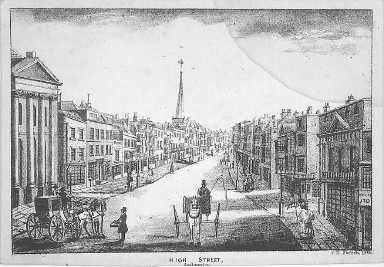 Southampton High Street, 18th C.
Southampton High Street, 18th C.4 February 1813 (Chawton, regarding PP):
In the following letters, we read a bit about Austen’s first beta readers for Pride and Prejudice and her reactions to their commentary:
“My dear Cassandra,—Your letter was truly welcome, and I am much obliged to you for all your praise; it came at a right time, for I had had some fits of disgust. Our second evening’s reading to Miss B. had not pleased me so well, but I believe something must be attributed to my mother’s too rapid way of getting on: though she perfectly understands the characters herself, she cannot speak as they ought. Upon the whole, however, I am quite vain enough and well satisfied enough. The work is rather too light and bright and sparkling: it wants shade; it wants to be stretched out here and there with a long chapter of sense, if it could be had; if not, of solemn specious nonsense, about something unconnected with the story,—an essay on writing, a critique on Walter Scott, or the history of Buonaparte, or something that would form a contrast, and bring the reader with increased delight to the playfulness and epigrammatism of the general style…. The greatest blunder in the printing that I have met with is in page 220, v. 3, where two speeches are made into one. There might as well be no suppers at Longbourn; but I suppose it was the remains of Mrs. Bennet’s old Meryton habits.”Dated soon after:
“I am exceedingly pleased that you can say what you do, after having gone through the whole work, and Fanny’s praise is very gratifying. My hopes were tolerably strong of her, but nothing like a certainty. Her liking Darcy and Elizabeth is enough. She might hate all the others, if she would. I have her opinion under her own hand this morning, but your transcript of it, which I read first, was not, and is not, the less acceptable. To me it is of course all praise, but the more exact truth which she sends you is good enough.”Garden Plans at Castle SquareAs most gardeners (myself included) can attest, planning one’s spring garden is a happy prospect in the middle of February. Jane Austen was no different! With that in mind, let’s take a closer look at her descriptions of the plans for their garden from her 8 February 1807 letter to Cassandra:
Austen’s Southampton GardenOur garden is putting in order by a man who bears a remarkably good character, has a very fine complexion, and asks something less than the first. The shrubs which border the gravel walk, he says, are only sweetbriar and roses, and the latter of an indifferent sort; we mean to get a few of a better kind, therefore, and at my own particular desire he procures us some syringas. I could not do without a syringa, for the sake of Cowper’s line. We talk also of a laburnum. The border under the terrace wall is clearing away to receive currants and gooseberry bushes, and a spot is found very proper for raspberries.Letter to Cassandra, 8 February 1807.
With these lovely descriptions, we can paint a picture in our minds of what Austen was imagining as she planned the garden:
Sweet Briar
Austen wrote: “The shrubs which border the gravel walk, he says, are only sweetbriar and roses, and the latter of an indifferent sort; we mean to get a few of a better…”
On the blog From the Notebook of a Rosarian, you can read all about Sweet-Briar (or Eglantine Rose). I imagine Austen would have looked forward to seeing these blooms very much! Here is an example:

Regency Roses
Austen wrote: “roses . . . of an indifferent sort; we mean to get a few of a better…”
Perhaps the existing roses either weren’t uniform or weren’t as pretty as the Austen women wanted. Thus, they planned to add a few of “a better” sort. One can imagine a line of beautiful roses along their walkway come summer.
You can read a wonderful article about Regency Roses from Leeds University Library here: Regency Roses. Here is an example:
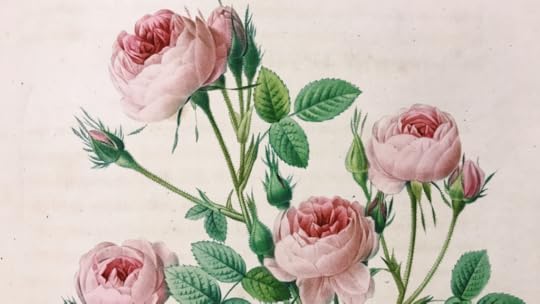 Pierre-Joseph Redouté, ‘Les Roses’, 1817-1824. Image credit: Leeds University Library.
Pierre-Joseph Redouté, ‘Les Roses’, 1817-1824. Image credit: Leeds University Library.Syringa (Lilac)
Austen wrote: “I could not do without a syringa, for the sake of Cowper’s line. We talk also of a laburnum.” This is in reference to a line in William Cowper’s poem, “The Winter Walk at Noon” (Book VI, The Task, 1899).
In her article “‘With what intense desire she wants her home’: Cowper’s Influence on Jane Austen,” Jane Darcy provides the following commentary:
The house in Castle Square in Southampton feels more like a home [for Austen]; there is a garden which she energetically starts to plan. She insists on lilacs: ‘I could not do without a Syringa, for the sake of Cowper’s Line’, adding ‘We talk also of a Laburnum’, referring to the lines in ‘The Winter Walk at Noon’,
Book VI of The Task:
… Laburnum rich
In streaming gold; syringa iv’ry pure (149-150)Jane Darcy, CowperandNewtonMuseum.org
 Edward Phillis, “A Georgian Springtime” (
Strictly Jane Austen
).Laburnum
Edward Phillis, “A Georgian Springtime” (
Strictly Jane Austen
).LaburnumAusten wrote: “We talk also of a laburnum.”
Laburnum, a flowering tree, also called golden chain or golden rain, is pictured below. One can imagine how lovely it would look in Austen’s garden in spring.
 Laburnum, flowering tree. Wikimedia.
Laburnum, flowering tree. Wikimedia.Austen wrote: “The border under the terrace wall is clearing away to receive currants and gooseberry bushes, and a spot is found very proper for raspberries.”
Here, we find an example of something pretty and edible for the garden come summer. Currants, gooseberries, and raspberries were all useful in a variety recipes. You can read more about the history of British food and Gooseberries here.
 Gooseberries, Britishfoodhistory.com.
Gooseberries, Britishfoodhistory.com.To read more about the trees and shrubs Austen would have recognized, the JASNA Eastern Washington/Northern Idado region provides this fascinating information regarding the “Trees and Shrubs Mentioned in Jane Austen’s Novels, Letters, and Minor Works with Historical Background: “Austen’s Trees and Shrubs A-K” and “Austen’s Trees and Shrubs L-Z.”
February in Jane Austen’s NovelsThe following are a collection of interesting little tidbits and important moments from Austen’s novels:
Sense and Sensibility
“[Mrs. Palmer] expects to be confined in February,” continued Mrs. Jennings.“[Edward] will be there in February, otherwise London would have no charms for me; I have not spirits for it.” (Lucy Steele)Colonel Brandon: “But last February, almost a twelvemonth back, [my little Eliza] suddenly disappeared.” […] “Good heavens!” cried Elinor, “could it be—could Willoughby!”—“[Mrs. Dashwood] had yet another reason for wishing her children to remain [in London]; a letter from her son-in-law had told her that he and his wife were to be in town before the middle of February, and she judged it right that they should sometimes see their brother.”“Early in February, within a fortnight from the receipt of Willoughby’s letter, Elinor had the painful office of informing her sister that he was married.”Pride and Prejudice
“With no greater events than these in the Longbourn family, and otherwise diversified by little beyond the walks to Meryton, sometimes dirty and sometimes cold, did January and February pass away.”Mansfield Park
“With such thoughts as these, among ten hundred others, Fanny proceeded in her journey safely and cheerfully, and as expeditiously as could rationally be hoped in the dirty month of February. They entered Oxford , but she could take only a hasty glimpse of Edmund’s college as they passed along, and made no stop anywhere till they reached Newbury, where a comfortable meal, uniting dinner and supper, wound up the enjoyments and fatigues of the day.”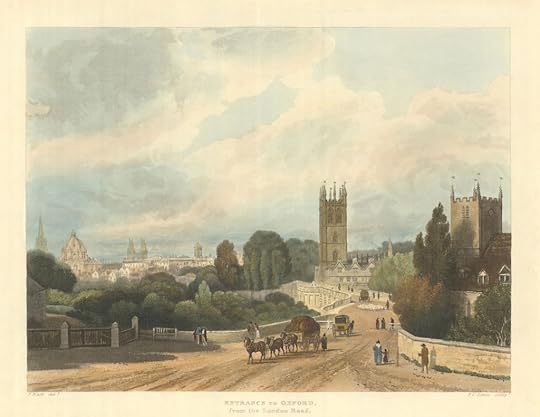 “Entrance to Oxford from the London Road.” Ackermann’s Oxford University. Engraved by Frederick Christian Lewis after Frederick Nash (1814).
“Entrance to Oxford from the London Road.” Ackermann’s Oxford University. Engraved by Frederick Christian Lewis after Frederick Nash (1814).Emma
“In the summer it might have passed; but what can any body’s native air do for them in the months of January, February, and March? Good fires and carriages would be much more to the purpose in most cases of delicate health, and I dare say in her’s. I do not require you to adopt all my suspicions, though you make so noble a profession of doing it, but I honestly tell you what they are.”“Frank was here in February for a fortnight.”“When [Frank] was here before, we made the best of it; but there was a good deal of wet, damp, cheerless weather; there always is in February, you know, and we could not do half that we intended. Now will be the time.“Mr. Woodhouse was resigned. The time of year lightened the evil to him. May was better for every thing than February.”Persuasion
“It was the beginning of February; and Anne, having been a month in Bath, was growing very eager for news from Uppercross and Lyme.”Mary Musgrove sends a long, newsy letter to Anne from Uppercross.Northanger Abbey
“Catherine . . . gave herself up to all the enjoyment of air and exercise of the most invigorating kind, in a fine mild day of February, with the consciousness of safety.” Bath, England, Regency Era.February Dates of Importance
Bath, England, Regency Era.February Dates of ImportanceThis brings us now to several dates that would have been quite important to Austen personally:
Celebrations/Birthdays:
13 February 1765: James Austen (Jane’s brother) born at Deane.
Historic Dates:
1 February 1793: France declares war on England.
4 February 1794: France abolishes slavery in French colonies.
February 1811: George, Prince of Wales, becomes the prince regent of England.
Sorrows:
22 February 1794: Eliza de Feuillide’s husband is executed by guillotine in Paris.
February 1797: Tom Fowle (Cassandra’s fiancé), who was serving as a chaplain, dies in San Domingo of yellow fever.
Writing:
Winter 1810: Sense and Sensibility accepted for publication (Thomas Egerton).
February 1811: Jane Austen starts work on Mansfield Park.
 Sense and Sensibility, 1st edition, JaneAusten’s.House.February in the Life of Austen
Sense and Sensibility, 1st edition, JaneAusten’s.House.February in the Life of AustenI hope you enjoyed this tour of February in Jane Austen’s World as much as I enjoyed researching it and writing it. There is so much more to explore! I followed several intriguing trails and threads in this article, but I’m sure one might find many other avenues to research. Austen’s letters alone are a fount of information and charm. Here’s to what we’ll find in March next month!
RACHEL DODGE teaches college English classes, gives talks at libraries, teas, and book clubs, and writes for Jane Austen’s World blog. She is the bestselling author of The Little Women Devotional, The Anne of Green Gables Devotional and Praying with Jane: 31 Days Through the Prayers of Jane Austen. Now Available: The Secret Garden Devotional! You can visit Rachel online at www.RachelDodge.com.
The post February in Jane Austen’s Novels first appeared on Rachel Dodge.
February 1, 2024
Literary Heart-Swoons!
What’s your favorite Anne+Gil moment, Kindred Spirits? What do you love most about their darling, slow-burn romance?!
It’s HEART-SWOON month, and I can’t wait to celebrate all of my favorite Literary Romances and Bosom Friends with you for Galentine’s/Valentine’s Month!
I’m starting with Anne and Gil because…YOU KNOW WHY!!!
That sideways smile. That wink that’s coming. (If you know, you know!) He’s so swoony, I’m swooning just writing about it!
Anne and Gil are one of the best and most romantic couples ever written and you can’t change my mind!
So tell me, tell me, what is it about Anne and Gil that makes you SWOON!!!
Here’s to a beautiful book-love month, Kindred Spirits!
Rachel xx
The post Literary Heart-Swoons! first appeared on Rachel Dodge.
January 11, 2024
January in Jane Austen’s World
Today marks the start of a new series, in which I highlight several important events and details that happened in Jane Austen’s novels, letters, and lifetime during each month of the year.
We’ll kick off Jane Austen January (aka “Jane-uary”) by examining passages and situations in each of her novels that occur in January. While some of the novels have no mention of January, others do—with interesting results! Next, we’ll note where Austen was and what she was doing in January by checking her letters for January dates and details. Finally, we’ll highlight events and anniversaries that occurred in January that directed affected Jane Austen or her family.
All of this can help us better understand Austen’s life and times as we look at specific dates, events, and details in the context of months and seasons.
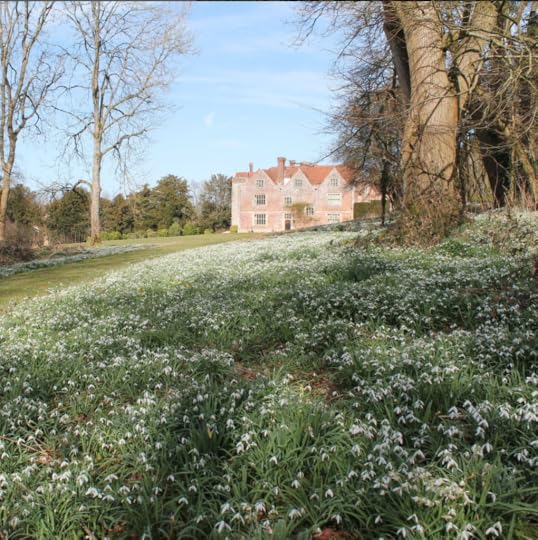 Snowdrops at Chawton House in January, courtesy of Chawton House.January in Regency Times
Snowdrops at Chawton House in January, courtesy of Chawton House.January in Regency TimesOne of the highlights of January for Jane Austen’s family was surely Twelfth Night (also known as Epiphany), which falls on January 5th.
Maria Grace, in her article “Celebrating Twelfth Night–Jane in January and You,” explains its religious importance: “Epiphany or Twelfth Night … was the exciting climax of the Christmastide season… It was a feast day to mark the coming of the Magi bearing gifts to the Christ child, and as such was the traditional day to exchange gifts.”
She also explains the social side of Twelfth Night: “In Jane Austen’s day, the party of the year would generally be held on Twelfth Night.” (Austen Variations)
During the Regency Era, people hosted parties and balls to celebrate Christmas and especially the last day of the Christmas season. The entertainment often involved guests playing assigned parts for the evening, dressing up in costumes, eating “Twelfth Cake,” and eating and drinking.
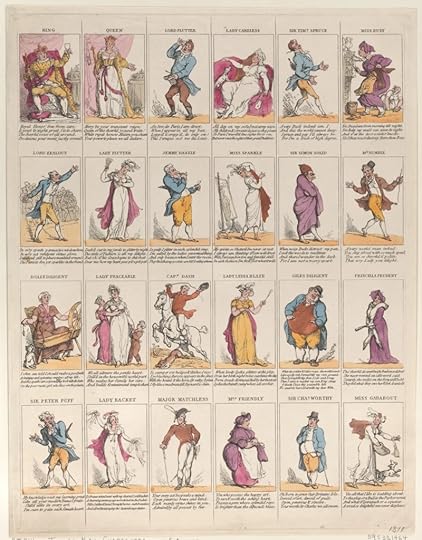 Rowlandson, “Twelfth Night Characters,” Creative Commons, 1811.
Rowlandson, “Twelfth Night Characters,” Creative Commons, 1811.In a letter to Cassandra on December 27, 1808, Austen writes about an upcoming ball between Christmas and “Twelfth-day” at Manydown:
I was happy to hear, chiefly for Anna’s sake, that a ball at Manydown was once more in agitation; it is called a child’s ball, and given by Mrs. Heathcote to Wm. Such was its beginning at least, but it will probably swell into something more. Edward was invited during his stay at Manydown, and it is to take place between this and Twelfth-day. Mrs. Hulbert has taken Anna a pair of white shoes on the occasion.Austen’s Letters (December 27, 1808)
Later, on January 10, 1809, she writes, “The Manydown ball was a smaller thing than I expected, but it seems to have made Anna very happy. At her age it would not have done for me.”
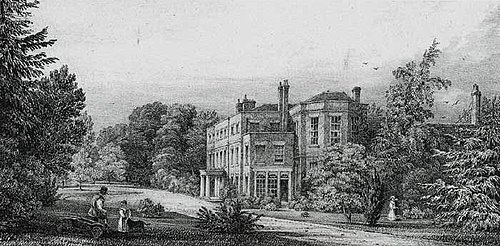 Manydown Great House, Wikipedia Commons, 1833.January Travel in Jane Austen’s Novels
Manydown Great House, Wikipedia Commons, 1833.January Travel in Jane Austen’s NovelsIn Austen’s novels, January is primarily mentioned in the context of parties and travel. Anne Elliot goes to Bath for January and February, Miss Crawford is invited for “a long visit” to see her friend in London in January, Mrs. Jennings goes to her own house in London in January, and Mr. Bingley, Mr. Darcy, and Bingley’s sisters all go to London (when Bingley leaves Netherfield) and stay for the winter.
In Sense and Sensibility, Lucy Steele and her sister, Anne, go to “town” (London) in January to stay with relatives (and subsequently move from house to house throughout the season as socially advantageous opportunities become available):
I had quite depended upon meeting you there. Anne and me are to go the latter end of January to some relations who have been wanting us to visit them these several years! But I only go for the sake of seeing Edward. He will be there in February, otherwise London would have no charms for me; I have not spirits for it.Sense and Sensibility
Mrs. Jennings, who “resided every winter in a house in one of the streets near Portman Square,” invites Elinor and Marianne to come with her to London in January when her thoughts begin to turn toward home after Christmas.
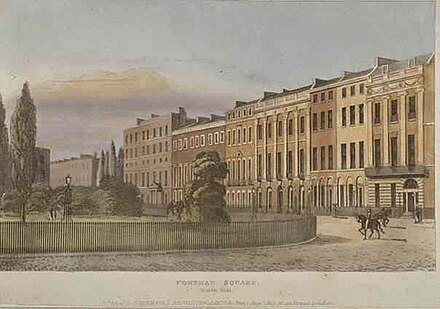 Portman Square, London, Wikipedia Commons, 1813.The London Season
Portman Square, London, Wikipedia Commons, 1813.The London SeasonSo why do so many of Austen’s characters travel to London in January? Wouldn’t the weather make travel difficult? Wouldn’t they prefer to stay home (and inside) where it’s cozy?
These are fair questions, but after Christmas, a large portion of the genteel class moved “to town” during the winter months for the London Season, which coincided with England’s political schedule, for entertainment and socializing. The Season had previously started in the fall, meaning most people went to London before the bad weather set in, but with the improvement of roads and travel during Austen’s day, the season slowly shifted later.
Here’s an explanation of the London Season from Jane Austen’s House Museum:
The London season coincided with the sitting of Parliament, beginning at some point after Christmas when fashionable families would move into their London houses. The men would attend Parliament, whilst the women shopped, visited, and found husbands for themselves or their daughters. It lasted until early summer, when the ‘beau monde’ would return to their country estates, escaping the city’s stifling heat and pungent smells.
The season was a whirlwind of court balls and concerts, private balls and dances, parties and sporting events. On a typical day, ladies would rise early to go riding in Hyde Park, before returning home to breakfast and spending the day shopping, dealing with correspondence and paying calls.The Season, Jane Austen’s House Museum
Most villages had assemblies and balls during the winter, but all of the most important social occasions happened “in town.” In Pride and Prejudice, we’re told that the Bennet sisters have little to do “beyond the walks to Meryton” in January and February, when conditions are “sometimes dirty and sometimes cold” (Ch. 27). It makes sense that many young women longed to go to town in the winter, at the height of the London Season and “marriage market,” when the majority of the parties, balls, and social events were held.
 Rowlandson, Drawing Room at St. James’s Palace in London, Wikimedia Commons, 1810.January in Jane Austen’s Letters
Rowlandson, Drawing Room at St. James’s Palace in London, Wikimedia Commons, 1810.January in Jane Austen’s LettersJanuary often brings rain, cold weather, and even snow to the various locations where Austen lived and traveled. Austen kept her spirits up, but January in England, especially in homes without central heating or today’s insulation, could not have been entirely comfortable. Balls and assemblies, visits and travel, kept Austen busy and content during the winter months.
Austen’s entries follow below and give us a glimpse into the miserable weather conditions during one particularly snowy and wet January:
17 January 1809 (Castle Square):
“Yes, we have got another fall of snow, and are very dreadful; everything seems to turn to snow this winter.”
24 January 1809 (Castle Square):
“This day three weeks you are to be in London, and I wish you better weather; not but that you may have worse, for we have now nothing but ceaseless snow or rain and insufferable dirt to complain of; no tempestuous winds nor severity of cold. Since I wrote last we have had something of each, but it is not genteel to rip up old grievances.”
In the same letter, Austen describes her writing:
“I am gratified by her having pleasure in what I write, but I wish the knowledge of my being exposed to her discerning criticism may not hurt my style, by inducing too great a solicitude. I begin already to weigh my words and sentences more than I did, and am looking about for a sentiment, an illustration, or a metaphor in every corner of the room. Could my ideas flow as fast as the rain in the store-closet, it would be charming.”
On the topic of the store-closet, she writes this:
“We have been in two or three dreadful states within the last week, from the melting of the snow, etc., and the contest between us and the closet has now ended in our defeat. I have been obliged to move almost everything out of it, and leave it to splash itself as it likes.”
30 January 1809 (Castle Square):
“Here is such a wet day as never was seen. I wish the poor little girls had better weather for their journey; they must amuse themselves with watching the raindrops down the windows. Sackree, I suppose, feels quite broken-hearted. I cannot have done with the weather without observing how delightfully mild it is; I am sure Fanny must enjoy it with us. Yesterday was a very blowing day; we got to church, however, which we had not been able to do for two Sundays before.”
And a final update on the flooded closet:
“The store-closet, I hope, will never do so again, for much of the evil is proved to have proceeded from the gutter being choked up, and we have had it cleared. We had reason to rejoice in the child’s absence at the time of the thaw, for the nursery was not habitable. We hear of similar disasters from almost everybody.”
If you’ve ever dealt with water damage or burst pipes due to cold weather, you know how awful and destructive it can be. Austen makes light, but one can imagine it caused quite a bit of damage.
 Snow at Jane Austen’s House Museum, January 2021.January in Jane Austen’s Lifetime
Snow at Jane Austen’s House Museum, January 2021.January in Jane Austen’s LifetimeAnd finally, let us turn our attention to some of the most important dates and events that happened (or were celebrated) during the first month of the year in Jane Austen’s lifetime. In December 1800, Reverend Austen decided to retire and remove his family to Bath. Austen’s letters in January 1801 prove an interesting read as she and the Austen family prepare to move later in the year:
3 January 1801 (Steventon):
Austen writes that her mother wants to keep two maids and quips about their plans to have “a steady cook and a young giddy housemaid, with a sedate, middle-aged man, who is to undertake the double office of husband to the former and sweetheart to the latter.”
Austen discusses three parts of Bath where they might live:
“Westgate Buildings, Charles Street, and some of the short streets leading from Laura Place or Pulteney Street.” She writes extensively about each neighborhood and several others, giving her opinion and hopes about each. She details which pictures, furniture, and beds they are choosing to keep or leave behind and asks Cassandra’s advice. And she shares plans for the family to travel to Bath a few weeks from then.
Austen shares own thoughts on their move to Bath:
“I get more and more reconciled to the idea of our removal. We have lived long enough in this neighborhood: the Basingstoke balls are certainly on the decline, there is something interesting in the bustle of going away, and the prospect of spending future summers by the sea or in Wales is very delightful. For a time we shall now possess many of the advantages which I have often thought of with envy in the wives of sailors or soldiers. It must not be generally known, however, that I am not sacrificing a great deal in quitting the country, or I can expect to inspire no tenderness, no interest, in those we leave behind…”
The letter is full of useful information and well-worth a read. You can access it HERE.
14 January 1801 (Steventon):
Austen speaks of the many visitors they’ve received in response to the news that Rev. Austen is retiring and the family is moving to Bath. She says, “Hardly a day passes in which we do not have some visitor or other: yesterday came Mrs. Bramstone, who is very sorry that she is to lose us, and afterwards Mr. Holder, who was shut up for an hour with my father and James in a most awful manner.”
 4 Sydney Place, Bath.
4 Sydney Place, Bath.
 Plaque outside 4 Sydney Place, Bath.January Dates of Importance
Plaque outside 4 Sydney Place, Bath.January Dates of ImportanceThis brings us now to several dates that would have been quite important to Austen personally:
Celebrations/Birthdays:
9 January 1773: Jane Austen’s sister, Cassandra Elizabeth Austen, born.
23 January 1793: Edward Austen’s first child, Fanny, born.
Goodbyes/Sorrows:
January 1796: Tom Lefroy leaves Ashe for London (and never returns) and Tom Fowle (Cassandra’s fiancé) sets sail for the Indies, where he later dies.
21 January 1805: Rev. George Austen (Jane’s father) dies suddenly in Bath.
Writing:
28 January 1813: Pride and Prejudice was published, by Thomas Egerton (Whitehall, London).
21 January 1814: Austen begins writing Emma.
The Joys of SleuthingI hope you’ve enjoyed this first installment of our month-by-month exploration of Jane Austen’s world. I was pleasantly surprised to find that there was so much more to research and explore about the month of January than I anticipated. I enjoyed sleuthing around, following my nose, and discovering what I could uncover–just with the word “January.” If I’ve missed anything major related to January, or if you have ideas about what I might pursue for February, please share it in the comments. It takes a village with this type of research!
RACHEL DODGE teaches college English classes, gives talks at libraries, teas, and book clubs, and writes for Jane Austen’s World blog. She is the bestselling author of The Little Women Devotional, The Anne of Green Gables Devotional and Praying with Jane: 31 Days Through the Prayers of Jane Austen. Now Available: The Secret Garden Devotional! You can visit Rachel online at www.RachelDodge.com.
The post January in Jane Austen’s World first appeared on Rachel Dodge.
December 31, 2023
A new tomorrow…with no mistakes in it.
“Marilla, isn’t it nice to think that tomorrow is a new day with no mistakes in it yet?” – Anne Shirley, Anne of Green Gables
Isn’t it nice to think that tomorrow is a new YEAR with no mistakes in it yet? I love taking this week between Christmas and New Year’s Day to slow down, ponder, and reflect.

It’s good to take stock of the year,
make new plans,
pray about what’s next,
organize our homes,
de-clutter our lives,
cut out non-essentials,
give thought to our choices,
focus on healthier habits,
work on self-restraint,
draw closer to God.
However, it can also be overwhelming to set goals and plans for a whole year. It’s hard to know that some of the resolutions we make tonight may fall by the wayside in a few days or weeks.
That’s why I always like to remind myself that every day is a new day with no mistakes in it yet.

Every day is a new tomorrow.
Every day is a fresh start.
Every day is a brand new opportunity to grow closer to God, follow His ways, and make His priorities our priorities.
My 2023 started with burst pipes and a flooded garage, office, and closet. It was NOT an awesome way to start the year.
It taught me that the way a year starts or finishes really doesn’t have any bearing on God’s plans for our lives. Some years are better than others. Some years are harder (or MUCH harder than others). But God is with us through it all.

So, if looking at a new year causes you to feel overwhelmed or stressed or funky, or if looking back at this past year causes you to feel regret or guilt, then just remember that tomorrow is a new day.
Tomorrow is a new day with the Lord. Every day is filled with new potential. And His mercies are new for each day.
“The steadfast love of the Lord never ceases; his mercies never come to an end; they are new every morning; great is your faithfulness” (Lam. 3:22-23)
Happy New Year to you, Kindred Spirits! I wish you the absolute best in 2024!
Rachel xx
The post A new tomorrow…with no mistakes in it. first appeared on Rachel Dodge.
December 14, 2023
Happy Birthday, Jane!
This Saturday, December 16th, we wish Jane Austen a very happy birthday! Austen fans and groups around the globe will unite this weekend to celebrate our favorite author, her incredible life, and the novels she wrote.
Here are a few ways you can join in the fun!
 Design: Rachel Dodge; Image: James Edward Austen-Leigh, Memoir of Jane Austen, London 1870, Wikimedia Commons.Schedule a Jane-a-Thon
Design: Rachel Dodge; Image: James Edward Austen-Leigh, Memoir of Jane Austen, London 1870, Wikimedia Commons.Schedule a Jane-a-ThonWhen is the last time you took a full day off to read Jane Austen’s beloved novels? I can’t imagine a better way to honor her life and celebrate her birthday!
My daughter schedules 24-hour read-alongs with her best friend whenever she has a break from school. I could never handle 24 hours of reading without falling asleep (ah, to be young!), but when I watch them gather their snacks, make their reading schedule, and read around the clock together for a full 24 hours, I always find it inspiring. Don’t you?
Schedules permitting, perhaps you might block off a day or half a day and devote yourself to a Jane-a-thon! Can you imagine spending the whole day with your nose in a Jane Austen novel (or two)?
You might also take a tour of her novels: You could read your favorite portions of each novel, read all the opening chapters and compare Austen’s style in each, or read all of the final chapters and see which one is most satisfying.
 Photo: Rachel DodgeWatch the Films
Photo: Rachel DodgeWatch the FilmsAnother favorite way to celebrate Austen is to have a movie marathon. You can do this alone or with a friend (or a group of friends)! If you want to do a true marathon, you can try to cover all six novels in a day or pick one novel and watch several versions to compare them.
I personally love to turn on the 6-hour, BBC version of Pride and Prejudice (1995) and get some of my Christmas projects done! It’s the prefect movie to watch while you wrap gifts, stuff Christmas cards, bake cookies, or work on other projects.
 Jennifer Ehle as Elizabeth Bennet, Pride and Prejudice (1995).Eat Good Food!
Jennifer Ehle as Elizabeth Bennet, Pride and Prejudice (1995).Eat Good Food!Whether you’re reading Austen’s novels, watching the movie adaptations, or honoring Jane in other creative ways, you must buy or make a few treats to eat in honor of Jane. A traditional English tea can be prepared with homemade or store bought cakes, scones, sandwiches, or other tasty treats.
Truly adventurous bakers might try their hand at traditional Regency baked goods. There are many recipes online, in the many Jane Austen cookbooks that have been published over the years, and in several tea time books devoted to Jane Austen. Here is one of my favorites!
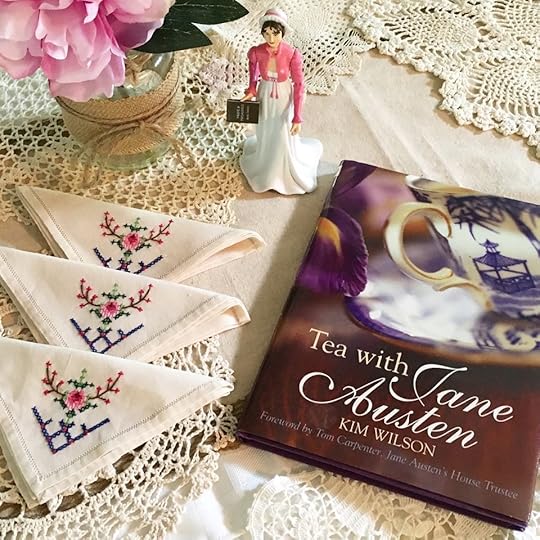 Photo: Rachel Dodge;
Tea with Jane Austen
, Kim Wilson
Photo: Rachel Dodge;
Tea with Jane Austen
, Kim WilsonYou might even try your hand at making a sponge cake in honor of Jane!
You know how interesting the purchase of a sponge-cake is to me.Jane Austen, Godmersham: Wednesday (June 15), Letter to Cassandra
 A delightful Sponge-cake (
Bite From the Past
)
A delightful Sponge-cake (
Bite From the Past
)This recipe from Bite From the Past looks lovely. Angela Hursh provides helpful step-by-step instructions for making the recipe for Jane Austen’s Sponge Cake from Cooking with Jane Austen and Friends by Laura Boyle (now out of print).
Join the Party!If you really want to go all-out, Jane Austen’s Virtual Birthday Party, hosted by Jane Austen’s House Museum, is a much-loved annual tradition. If you’ve never joined the party online, there is room for everyone! Jane’s birthday falls on Saturday this year, so reserve your spot and set your alarm (depending on your time zone).
Party guests will enjoy fabulous music, fascinating talks, beautiful readings, and all sorts of fun and games in the spirit of Jane Austen and her family.
Description from JAHM: “We’ll be joined by some very special guests! Enjoy a mini keynote by fabulous historian and broadcaster Lucinda Hawksley, a quick dive into Georgian prints by historian Alice Loxton, a dramatic reading by actor Rebecca Tanwen, a sneak peak into the making of the Jane Austen collection at Moorcroft Pottery, a reading by Jessica Bull from her debut novel Miss Austen Investigates, and beautiful music by pianist Laura Klein!”
Regency attire strongly encouraged!
Party Details:
Date: Saturday 16 December
Time: 8pm – 9pm (GMT)
Location: This event takes place online. Join in from the comfort of your own home!
Tickets: £10
Note: This event will be recorded so ticket holders can enjoy it at a later date if needed!
 Give a Gift
Give a GiftFinally, one tangible way to celebrate Jane Austen’s birthday is to consider giving a gift in her honor to Jane Austen’s House Museum. Chawton Cottage is lovely, secluded, and historic. I’ve visited the house several times, and it is an absolute treasure for Jane Austen fans. This is one simple way we can all play a part in preserving Jane Austen’s legacy both now and in the future.
The House Museum’s current Courtyard Restoration Appeal is designed to help raise funds toward repairing and restoring the roofs of the courtyard buildings, including the Bakehouse, cellars, offices, store rooms, and privy! You can find out more here.
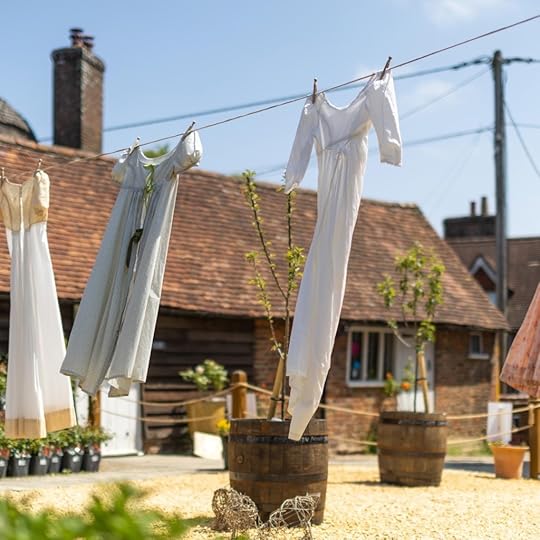 Photo: Courtesy of Jane Austen’s House MuseumHappy Birthday, Jane Austen!
Photo: Courtesy of Jane Austen’s House MuseumHappy Birthday, Jane Austen!Wherever your plans take you this weekend, I hope you’ll join me and everyone here at Jane Austen’s World in honoring and celebrating our Jane on her birthday. She has given us so much, and we all love her tremendously.
RACHEL DODGE teaches college English classes, gives talks at libraries, teas, and book clubs, and writes for Jane Austen’s World blog. She is the bestselling author of The Little Women Devotional, The Anne of Green Gables Devotional and Praying with Jane: 31 Days Through the Prayers of Jane Austen. Now Available: The Secret Garden Devotional! You can visit Rachel online at www.RachelDodge.com.
The post Happy Birthday, Jane! first appeared on Rachel Dodge.
November 16, 2023
Jane Austen’s Wardrobe (Book Review)
Dear readers, I have an exquisite new book to share with you today: Jane Austen’s Wardrobe by Hilary Davidson!
Filled with incredible photos and written information, it’s one of the most detailed books I’ve seen in a long time on this topic. Not only is it beautiful, it is filled with fascinating information on one of my most favorite topics.
This is my new favorite book on Jane Austen’s Regency Fashion. I know I’ll continue to pour over it for years to come!
 Austen’s Wardrobe by Category
Austen’s Wardrobe by CategoryWithin the pages of this lovely book, Davidson works her way through Austen’s personal wardrobe chronologically, from head to toe. Davidson’s system for cataloging Austen’s wardrobe is fascinating! For those of us who delight in a linear and/or chronological order to a wide and varied topic, Davidson definitely checks all the boxes.
First, she breaks all of Austen’s clothing down into the following categories:
Clothes Press: GownsCloset: Spencers, Pelisses and Outer GarmentsBand Box: Hats, Caps and BonnetsShelves: Shawls, Tippets, Cloaks and ShoesDressing Table: Gloves, Fans, Flowers, Trims and HandkerchiefsJewelery Box: Necklaces, Rings and BraceletsDrawers: Undergarments and NightwearDavidson even includes several pages of sketches, descriptions, and explanations for Jane’s “Portrait Gown” – which I found completely engrossing.
 Austen’s Letters Quoted
Austen’s Letters QuotedNext, Davidson utilizes Austen’s personal letters to explore every inch of Austen’s wardrobe, working her way through each category in chronological order. To do this, she shares one quote at time, citing portions of letters that mention Austen’s clothing. Then, for each article of clothing, every hat, and every piece of jewelry, she explains that quote in great detail and provides photos to aid our understanding.
For instance, Austen writes this in Letter 65:
“I can easily suppose that your six weeks here will be fully occupied, were it only in lengthening the waists of your gowns. I have pretty well arranged my spring & summer plans of that kind, & mean to wear out my spotted Muslin before I go. –You will exclaim at this–but mine has signs of feebleness, which with a little care may come to something.”Tuesday 17 – Wednesday 18 January, 1809, Castle Square
Davidson provides photos of spotted muslin fabric swatches and a photo of a dress made of spotted muslin, dated 1805-10. Then she explains the muslin fabric, provides quotes from Austen’s novels about muslin dresses, and explains Austen’s quote. She goes over the dress styles, what was involved in “lengthening the waist” of a gown, the meaning of “worked” fabric, and the ins and outs of fragile fabrics of that time period, including how women used belts to cover holes in the fabric when a waist was lengthened.
I found this incredibly interesting because I’ve always been curious about Austen’s extensive quotes about her dresses and hats in her letters. The result is a delightful (and sometimes hilarious) tour through Jane Austen’s closet in her own words, with pictures and explanations to match!
Here are several more examples, provided by Yale University Press:
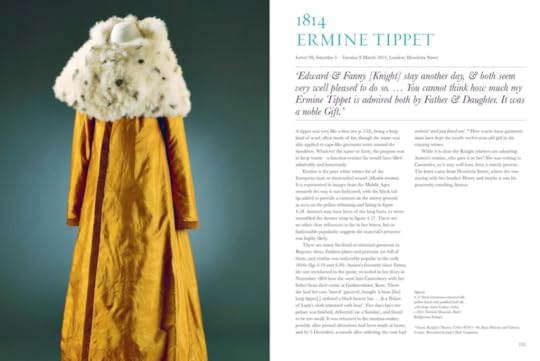
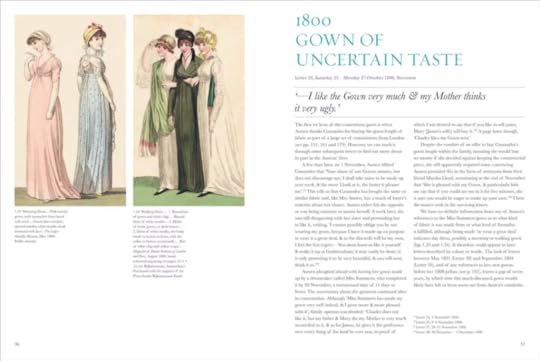 Informative and Beautiful
Informative and BeautifulLike many of Austen’s heroines, this book is both intelligent and beautiful. Inside and out, this book is absolutely stunning. The photos provide a detailed look into Jane Austen’s clothing that is hard to find, especially all in one place. This book feels like a worldwide museum tour of all the most exquisite clothing artifacts from Austen’s time.
This is the perfect addition to any Jane Austen library – and it will look gorgeous on your coffee table!
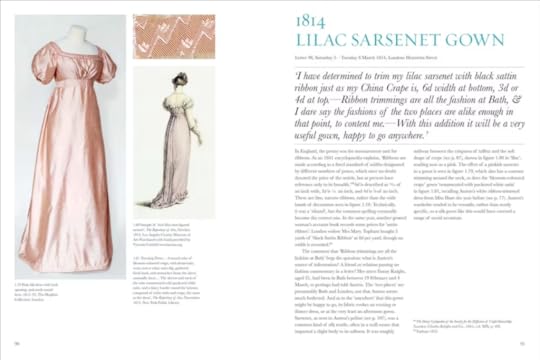
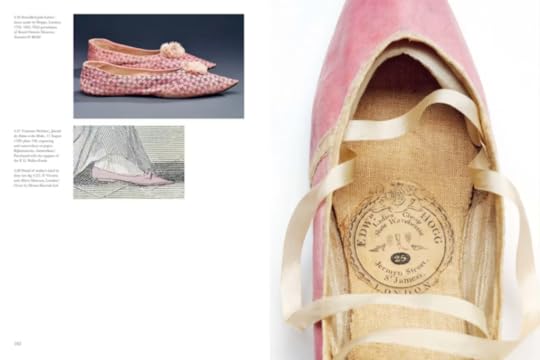 Book Description
Book DescriptionHilary Davidson delves into the clothing of one of the world’s great authors, providing unique and intimate insight into her everyday life and material world.
Acclaimed dress historian and Austen expert Hilary Davidson reveals, for the first time, the wardrobe of one of the world’s most celebrated authors. Despite her acknowledged brilliance on the page, Jane Austen has all too often been accused of dowdiness in her appearance. Drawing on Austen’s 161 known letters, as well as her own surviving garments and accessories, this book assembles examples of the variety of clothes she would have possessed—from gowns and coats to shoes and undergarments—to tell a very different story.
The Jane Austen Hilary Davidson discovers is alert to fashion trends but thrifty and eager to reuse and repurpose clothing. Her renowned irony and wit peppers her letters, describing clothes, shopping, and taste. Jane Austen’s Wardrobe offers the rare pleasure of a glimpse inside the closet of a stylish dresser and perpetually fascinating writer.

 About the Author
About the AuthorHilary Davidson is a dress, textile and fashion historian and curator. Her work encompasses making and knowing, things and theory, with an extraordinary understanding of how historic clothing objects come to be and how they function in culture.
Hilary is equally skilled in analysing historical and archaeological material culture artefacts; presenting engaging, fascinating talks to diverse audiences; and producing influential academic research.
Her extensive experience includes:
Scholarly researchLecturing, teaching and public talksBroadcasting and journalismHistoric dressmaking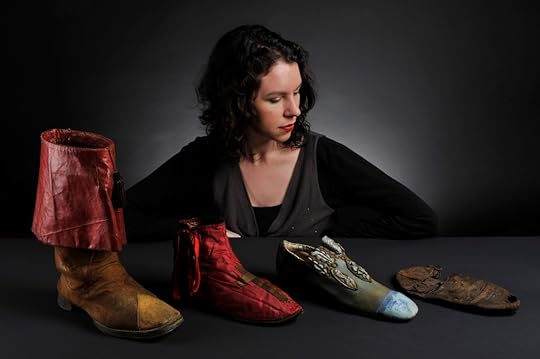
Hilary trained as a bespoke shoemaker in her native Australia before completing a Masters in the History of Textiles and Dress at Winchester School of Art (University of Southampton) in 2004. Since graduating, Hilary’s practice has concerned the relationship between theoretical and highly material approaches to dress history, especially in the early modern and medieval periods.
As a skilled and meticulous hand-sewer, she has created replica clothing projects for a number of museums, including a ground-breaking replication of Jane Austen’s pelisse.
In 2007 Hilary became curator of fashion and decorative arts at the Museum of London. She contributed to the £20 million permanent gallery redevelopment opening in 2010, and curated an exhibition on pirates, while continuing to publish, teach and lecture in the UK and internationally. In collaboration with Museum of London Archaeology, Hilary began analysing archaeological textiles and continues to cross disciplines by consulting in this area in England and Australia. She also worked on the AHRC 5-star rated Early Modern Dress and Textiles Network (2007-2009) and from 2011 has appeared as an expert on a number of BBC historical television programmes, and as a frequent radio guest speaker in London and Sydney.
From 2012 Hilary worked between Sydney and London as a freelance curator, historian, broadcaster, teacher, lecturer, consultant and designer, while working on a PhD in Archaeology at La Trobe University, Melbourne. In addition to historical studies she has been a jewellery designer, graphic designer, photographer, gallerist, and worked in retail fashion and vintage clothing. In 2022 she moved to New York City to take up the role of Associate Professor and Chair of the MA Fashion and Textile Studies: History, Theory, Museum Practice at the Fashion Institute of Technology.
Hilary has taught and lectured extensively, including at the University of Southampton, Central St Martins, the University of Cambridge, the University of Glasgow, New York University London, The American University Paris, Fashion Design Studio TAFE Sydney and the National Institute of Dramatic Art (NIDA), Sydney. She speaks regularly at academic conferences and to the public. Her first monograph book was Dress in the Age of Jane Austen (2019) followed by Jane Austen’s Wardrobe in 2023. Her extensive publications can be found on Academia and ResearchGate.
 To Order the Book:
To Order the Book:You can order the book by clicking HERE
or by clicking the image below:
 Recommended Book Gift
Recommended Book GiftI hope you’ve enjoyed this short tour of this stunning new book by Hilary Davidson. If you’re looking for a gift for a fellow Jane Austen fan, or if your friends or family members need an idea for a gift for you this holiday season, I highly recommend this one!

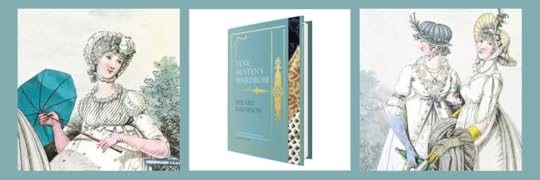

The post Jane Austen’s Wardrobe (Book Review) first appeared on Rachel Dodge.
October 15, 2023
A World of Octobers
“Oh, Marilla,” Anne exclaimed one Saturday morning, coming dancing in with her arms full of gorgeous boughs, “I’m so glad I live in a world where there are Octobers. It would be terrible if we just skipped from September to November, wouldn’t it? Look at these maple branches. Don’t they give you a thrill—several thrills? I’m going to decorate my room with them.”
Every year I celebrate #Annetober on my socials over @KindredSpiritBooks and breathe deeply of the month, the season, the mood, and the joy of October. This year, I wrote a little poem. Enjoy!

World of Octobers
It’s time.
Time to revel in color.
Time to listen and feel.
Time to breathe deep.
Fall is all around.
Falling
Leaves
Crunching underfoot.
It’s here.
The most beautiful month of the year.
October.
The month of my birth.
Glorious end-cap.
The month I long for most.
The month I can almost taste.
The smell.
The feel.
The world around me
slowly cooling and drying.
Crisp and brittle.
Smoky mist.
Colors swirling.
It’s time to draw in and curl up.
Sip deeply, slowly
as the hearth flame
flickers and winks.
—Rachel Dodge, 2023

Perhaps a mutual love for October is part of why I love Anne and always have since I was a little girl. What do you love about October, Kindred Spirits? What are some of your most favorite things to do when the seasons start to change?
Happy October!
Rachel xx
The post A World of Octobers first appeared on Rachel Dodge.
October 9, 2023
Love Triangles in Sense and Sensibility
Over the last few months, we’ve explored timeless romantic themes in Jane Austen’s novels that are still frequently used in today’s popular books, movies, and television shows. Thus far, we’ve covered the following themes in this series: “Enemies to Lovers” in Pride and Prejudice, the “Slow Burn” Romance in Emma, “Best Friends to Lovers” in Mansfield Park, “Second-Chance” Love in Persuasion, and “The Meet-Cute” in Northanger Abbey.
Last but certainly not least, this brings us to Sense and Sensibility and one of Austen’s most mature and intricate plots. Sense and Sensibility is unique in that it contains two main love stories with its sister-heroines, Elinor and Marianne Dashwood. Though Elinor is the main protagonist of the novel, Marianne’s romantic life is often front-and-center with its high drama and plot impact.
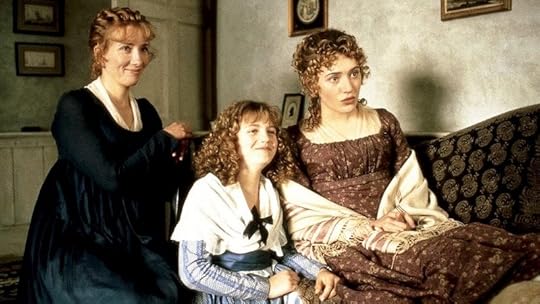 Love Triangles
Love TrianglesIn the world of storytelling, love triangles provide a potent plot device. There’s the age-old King Arthur-Guinevere-Lancelot story that’s been told again and again; the love triangle/identity mix-up in Shakespeare’s Twelfth Night; and the explosive Heathcliff-Cathy-Edgar triangle in Wuthering Heights. And this is only the tip of the iceberg. We could add dozens of other famous triangular love stories to this list.
In Sense and Sensibility, Austen provides her readers with not one, but two separate love triangles to untangle between Elinor-Edward-Lucy Steele and Marianne-Willoughby-Colonel Brandon.
In each of these triangles, there is one “wrong” person standing in the way of true love with Mr./Ms. Right. For Colonel Brandon, Willoughby takes the spotlight and all of Marianne’s attention. For Elinor, Lucy stands in the way of her happiness with Edward, due to an unfortunate youthful promise made by Edward.
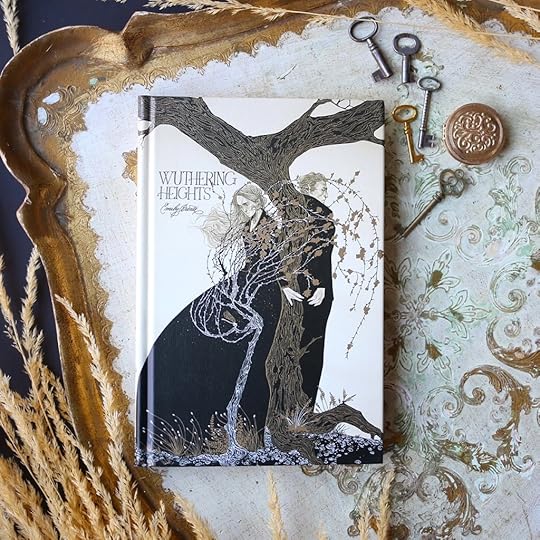 LitJoy Classics, Wuthering HeightsFalling for Mr./Ms. Wrong, Finding Mr./Ms. Right
LitJoy Classics, Wuthering HeightsFalling for Mr./Ms. Wrong, Finding Mr./Ms. RightIn both of these love triangles, a character falls for Mr./Ms. Wrong first and later finds Mr./Ms. Right. Elinor and Colonel Brandon both wait in the wings and watch to see if Edward and Marianne will break free from their previous attachments. They both must wait and wonder; they both feel the pain and angst of separation; and they both know that they may never find their personal happy ending.
The only difference is, Edward and Elinor have a mutual attachment to one another, while Marianne does not develop romantic feelings toward Colonel Brandon until far later in the novel. She thinks he’s far too old for romance and “thirty-five has nothing to do with matrimony”:
Colonel Brandon is certainly younger than Mrs. Jennings, but he is old enough to be my father; and if he were ever animated enough to be in love, must have long outlived every sensation of the kind. It is too ridiculous! When is a man to be safe from such wit, if age and infirmity will not protect him?Sense and Sensibility
Thus, Colonel Brandon must wait in the wings, ever true and ever patient, caring deeply for Marianne and wanting the best for her, even if it means watching her break her heart and health over Willoughby.
 Mr. Wrong: The Problem with Willoughby
Mr. Wrong: The Problem with WilloughbyAs in life, Jane Austen’s characters often have to fall for Mr./Ms. Wrong before they can appreciate Mr./Ms. Right. In some of her novels, she even uses a “red herring” to keep her readers distracted (Frank Churchill is one such example). In Sense and Sensibility, Marianne Dashwood falls for a young, dashing, handsome, attractive man who appears to be everything she’s ever hoped for in a man.
To make matters even more exciting, their “meet-cute” involves an intoxicating rescue scene where Willoughby lifts Marianne and carries her home after she falls down and is hurt. How could a young lady, especially a young romantic woman like Marianne, not fall for a strong, handsome man who literally sweeps her off her feet and carries her through the rain to safety.
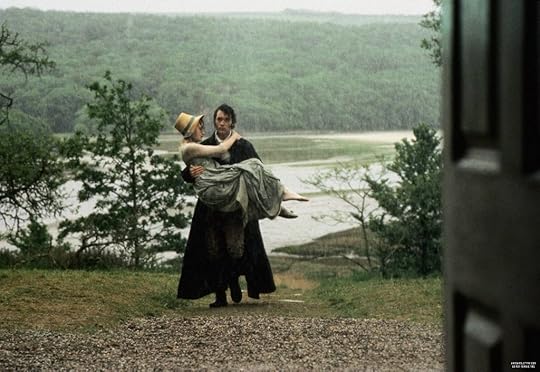
The problem is, no matter how dashing, friendly, attractive, romantic, or exciting Willoughby might appear, he is not who he seems. As we later find out from Colonel Brandon, Willoughby has a checkered past and has impregnated (at least) one young woman out of wedlock, without taking any responsibility for her care, sufficiently ruining her reputation and her chances (in that time/culture) of a happy future.
But, you might ask, how could anyone have known, since the fate of Colonel Brandon’s ward was unknown to any of the Dashwoods until much later? Though no one could believe just how bad he is, Austen does provide clues about Willoughby’s character through her descriptions of his conduct. He frequently crosses lines of propriety (usually a red flag in Austen’s novels) and makes himself far too cozy and familiar with Marianne without making any firm promises.
Today, dozens of movies and books follow a similar script. We often see characters like Mr. Willoughby, Mr. Wickham, and Mr. Crawford who are just a little bit too handsome, too dashing, and too perfect to actually be Mr. Right.
 Ms. Wrong: The Problem with Lucy Steele
Ms. Wrong: The Problem with Lucy SteeleThe problem with Lucy Steele is more a matter of youthful ignorance and inexperience. Edward Ferrars is captivated by Lucy’s beauty and, due in part to forced proximity, experiences young love and makes a commitment to someone who does not match his personality, intelligence, values, or interests in life. Austen describes her as “illiterate, artful, and selfish” – certainly no match for a thoughtful, principled man like Edward.
Not surprisingly, he soon regrets committing himself to a woman like Lucy:
The youthful infatuation of nineteen would naturally blind him to every thing but her beauty and good nature; but the four succeeding years—years, which if rationally spent, give such improvement to the understanding, must have opened his eyes to her defects of education, while the same period of time, spent on her side in inferior society and more frivolous pursuits, had perhaps robbed her of that simplicity which might once have given an interesting character to her beauty.Sense and Sensibility
And while Lucy at first only appears to be an ignorant, vapid girl without much sense, we quickly realize she is far less sweet and far more dangerous than meets the eye. She’s not in love with Edward; she merely sees him as a “way up.” We later find out that she’s a conniving “gold digger” (to use today’s terms) who is looking for any way to climb the social ladder and make the best match she can, regardless of who she hurts or what anyone thinks.
This type of female red herring shows up in many popular romantic movies and books today as well. However, in many of today’s plot lines, this type of female character tends to be some kind of shark in the business world who cares more about appearances and getting ahead than building a loving relationship and happy life with the handsome main character.
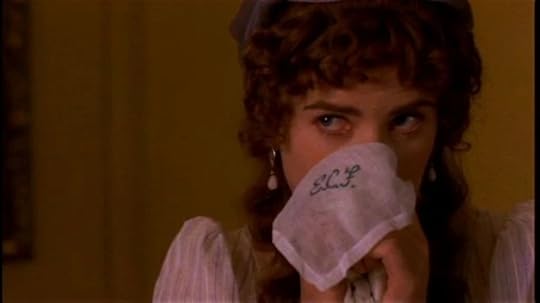 Finding Mr. (Colonel) Right
Finding Mr. (Colonel) RightMarianne must go through heartache before she can appreciate or fall in love with Colonel Brandon. He watches and waits, hoping against hope, until she begins to blossom and heal from her broken heart. His steadiness, thoughtfulness, and gentlemanlike manner is a welcome change from the high drama and passion of her first attachment, and soon an attachment forms:
Instead of falling a sacrifice to an irresistible passion, as once she had fondly flattered herself with expecting,—instead of remaining even for ever with her mother, and finding her only pleasures in retirement and study, as afterwards in her more calm and sober judgment she had determined on,—she found herself at nineteen, submitting to new attachments, entering on new duties, placed in a new home, a wife, the mistress of a family, and the patroness of a village.
Colonel Brandon was now as happy, as all those who best loved him, believed he deserved to be;—in Marianne he was consoled for every past affliction;—her regard and her society restored his mind to animation, and his spirits to cheerfulness; and that Marianne found her own happiness in forming his, was equally the persuasion and delight of each observing friend. Marianne could never love by halves; and her whole heart became, in time, as much devoted to her husband, as it had once been to Willoughby.Sense and Sensibility
In today’s popular movies and books, a character like Colonel Brandon is sometimes the childhood best friend or the nerdy next door neighbor that suddenly turns handsome. It’s usually a matter of the main character being blinded at first by a passionate but unhealthy relationship and then “coming to their senses” and noticing the quality person that’s been there all along.
As far as the age-gap between Brandon and Marianne (which was quite common during Austen’s day and culture), many of today’s romantic storylines, such as As Good as It Gets, Crazy Heart, and Autumn in New York, feature a May-December romance.
 Finding Ms. Right
Finding Ms. RightFrom the moment they meet, it’s clear that Elinor and Edward are perfect for one another in every way. For Edward, once he meets a woman of Elinor’s caliber, there is no question that she is far superior to Lucy Steele.
However, Edward is a man of his word and refuses to do wrong by Lucy Steele. This honorable choice only serves to make Edward more attractive, even though Elinor is pained deeply by the knowledge that he must marry an ignorant woman he does not love. Like Brandon, Elinor waits patiently, enduring much pain, until Edward is finally set free.
Dozens of movies and televisions shows use this type of plot line where the main character must come to the realization that their current relationship is all wrong and someone else is a much better fit. Sweet Home Alabama is one mainstream movie example of this type of love affair.
 Love Triangles in Popular Media
Love Triangles in Popular MediaMore romantic comedies feature a love triangle of some kind in today’s world of romantic writing.
The following are some popular movies (and/or books) with this theme: Pretty in Pink, While You Were Sleeping, The Notebook, Beauty and the Beast, Spider-Man, The Hunger Games, Titanic, Twilight (Team Edward v. Team Jacob), My Best Friend’s Wedding, Bridget Jones’s Diary, Sabrina, Reality Bites, Gone with the Wind, Something Borrowed, Pearl Harbor, Pirates of the Caribbean, and The Princess Bride.
Some well-known television love triangles include: Dawson’s Creek, Friends, Gilmore Girls, The Office, Beverly Hills 90210, Sex & The City, How I Met Your Mother, Felicity, Outlander, The Summer I Turned Pretty, Never Have I Ever, Friday Night Lights, Lost, and Grey’s Anatomy.
Though none of these shows or movies holds a candle to Austen’s writing, it’s clear that love triangles and plot twists about finding and/or waiting for Mr./Ms. Right continue to keep audiences coming back for more.
Happily Ever AfterIn the end, everyone lives happily ever after. (Except, of course, those characters whom Austen deems foolish or undeserving of true happiness.) As always, Austen provides her reader’s with a satisfying ending: “Let other pens dwell on guilt and misery. I quit such odious subjects as soon as I can, impatient to restore everybody not greatly in fault themselves to tolerable comfort, and to have done with all the rest.”
As we close this pop culture series on Jane Austen and Rom Coms, I’d love to know which couples and romantic themes are your favorite(s) in her novels!
The post Love Triangles in Sense and Sensibility first appeared on Rachel Dodge.
September 25, 2023
Book Review: On Moonberry Lake
If you could live anywhere (fictional or real), where would you live?
I’m adding Moonberry Lake with its funny townspeople to my fictional list!!! Along with Stars Hollow, Avonlea, Narnia, Mitford, and the Shire!
Holly Varni’s debut novel, On Moonberry Lake, releases today and you do not want to miss this book! If you’re looking for a little bookish escape, this is your ticket!
 Book description
Book descriptionCora Matthews’s life is a mess. A broken engagement and the unexpected death of her mother have left her wondering if things will ever return to normal. Whatever “normal” is.
It certainly isn’t what she finds at Moonberry Lake. After she receives her family’s dilapidated lakefront lodge as an inheritance–with a surprising condition attached–Cora finds her life overrun by a parade of eccentric neighbors who all have something to say and something to teach her.
As Cora works to put her life back together, she must decide if she is willing to let go of the past, open her heart to love, and embrace the craziest version of family and home she could ever have imagined.
-Revell Publishing, 2023
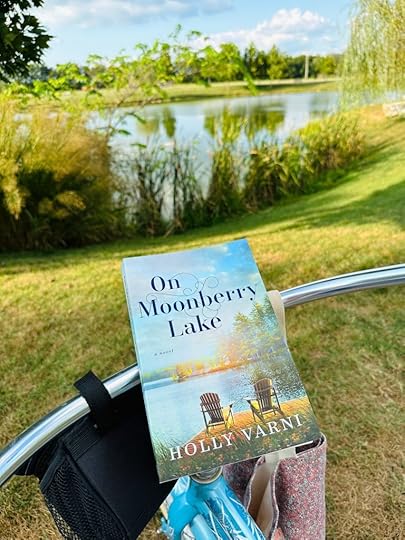 About the Author
About the AuthorHolly Varni is a native Minnesotan of strong Norwegian descent, who was raised in the Lutheran Church that Garrison Keillor made a career depicting. Between the lutefisk, grumpy grandparents, and crazy neighbors who mowed their lawn wearing pajamas, the seed to becoming a storyteller was planted. Though she, her husband, and their three sons live along the Central Coast of California, her beloved Midwest roots continue to haunt everything she writes. She hosts the Moments from Moonberry Lake podcast where she shares more stories of her beloved characters. Learn more at www.hollyvarni.com.

Holly Varni @hollyvarni is a dear friend of mine and one of the few people I know who could actually squeeze the life out of someone with a hug! She’s one of the most loving, warm, enthusiastic people I know – and all of that goodness comes out in her writing. I could not be more proud of my darling friend, and I hope you will read her lovely book!!
There’s more to come in this series from from Holly Varni, and I can’t wait!
Here’s to lovely fictional towns and all the happy books, Kindred Spirits!
Rachel xx
The post Book Review: On Moonberry Lake first appeared on Rachel Dodge.



